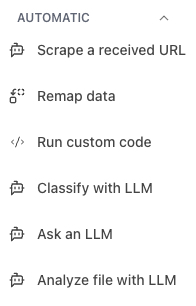Automatic
Here you will find all the available automatic nodes in the platform.
Actions

Scrape a received URL
Talk with the scrape wizard to configure the scraping of the received URLs
Fields:
- Label: The name of the automatic action as it will appear in the workflow editor.
- Description: A brief explanation of what is intendeed to do.
- Integration: A list of integrations to use for the scraping.
- URL: A URL to scrape the data from. Can use placeholders like
{{input.url}}. - API Endpoint URL: The URL to the API endpoint service to scrape the data from.
- Navigation steps: A list of steps to navigate through the page.
- Click: Click on a selector.
- Go to URL: Go to a URL.
- Wait for load state: Wait for a load state.
- Take a screenshot: Take a screenshot.
- Fill input: Fill an input indicating the selector and the value.
Remap data
Allows you to remap the data from the packet
Fields:
- Label: The name of the automatic action as it will appear in the workflow editor.
- Description: A brief explanation of what is intendeed to do.
- Add special data mapping: An option to include additional data mappings specific to this trigger. You will be able to map the data from the (input/metadata/entity params) to the (output/metadata).
Run custom code
Runs custom code with the packet data
Fields:
- Label: The name of the automatic action as it will appear in the workflow editor.
- Description: A brief explanation of what is intendeed to do.
- Code: The code to run. You can use placeholders like
{{input.url}}.- You will be able to return data to the packet using the
returnstatement likereturn { output: {}, metadata: {} }.
- You will be able to return data to the packet using the
Classify with LLM
Classifies the input data using the LLM model and returns the result in the corresponding exit
Fields:
- Label: The name of the automatic action as it will appear in the workflow editor.
- Description: A brief explanation of what is intendeed to do.
- Handles names: The names of the handles to use for the classification.
- Handler ID: The ID of the handler.
- Is Connectable: If the handler is connectable.
- Label: The label of the handler.
- Color: The color of the handler.
Ask an LLM
Answers a prompt using LLM models. It can also return structured data if needed.
Fields:
- Label: The name of the automatic action as it will appear in the workflow editor.
- Description: A brief explanation of what is intendeed to do.
- Integration: A list of integrations to use for the scraping.
- LLM: The LLM model to use for the classification.
- Prompt: The prompt to answer. Can use placeholders like
{{input.url}}.
Analyze file with LLM
Get an answer with LLMs based on a prompt and an image. It can also return structured data if needed.
Fields:
- Label: The name of the automatic action as it will appear in the workflow editor.
- Description: A brief explanation of what is intendeed to do.
- Integration: A list of integrations to use.
- LLM: The LLM model to use for the classification.
- File: Path in the packet input or metadata. It can be a reference to a URL or to a fileReference.
- Prompt: The prompt to answer. Can use placeholders like
{{input.url}}.